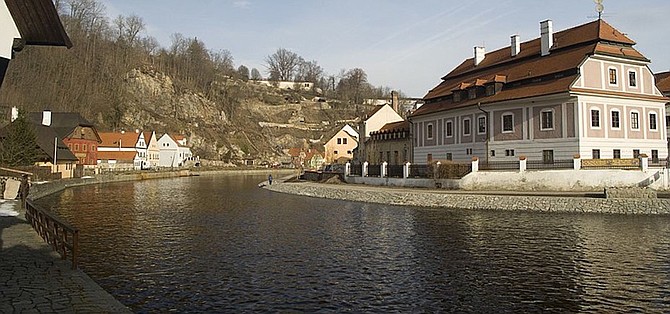 Facebook
Facebook
 X
X
 Instagram
Instagram
 TikTok
TikTok
 Youtube
Youtube

Having spent the last eight days in the Santa Cruz Mountains and having walked many a forest path, I began to consider the greatest music inspired by nature. What follows is by no means a comprehensive list. However, I’ve tried to include a variety of geographical locations.
Alexander Borodin was a Russian chemist and amateur composer. His symphonic poem *In the Steppes of Central Asia” is our first stop. Borodin included the following abstract with the score.
“In the silence of the monotonous steppes of Central Asia is heard the unfamiliar sound of a peaceful Russian song. From the distance, we hear the approach of horses and camels and the bizarre and melancholy notes of an oriental melody. A caravan approaches, escorted by Russian soldiers and continues safely on its way through the immense desert. It disappears slowly. The notes of the Russian and Asiatic melodies join in a common harmony, which dies away as the caravan disappears in the distance.”
Moving west but staying in Slavic lands we get to “Die Moldau” from Bederic Smetana’s Má Vlast (My Fatherland). The Moldau River, also called The Vltava, flows along the forests of Bohemia, thorough Prague and then into the Elbe River which empties into the North Sea.
The Moldau is the national river of the Czech Republic and is crossed by 18 bridges in Prague of which the Charles Bridge is the most famous.
Staying within the forest we find Siegfried resting under a Linden tree beside the ruins of the dragon Fafner whom he has slain in Richard Wagner’s opera Siegried. Siegfried looks up through the tree and becomes enchanted by the “Forest Murmurs” and the bird song which he can understand since he has been covered with the dragon’s blood.
If we turn south we approach the Alps and Richard Strauss’s Eine Alpen Symphonie. This is Strauss’s largest non-operatic composition. It requires an orchestra of 125 and describes a day on the mountain including a ferocious storm.
Continuing over the Alps we arrive in Italy and the hear Ottorino Respighi’s The Pines of Rome. The final movement is inspired by the pines of the Appian Way as the ghosts of the Roman legion march by in triumph.
Skipping across the channel we see the cliffs of Cornwall. “On the Cliffs of Cornwall” is the title of the Act II Prelude in Dame Ethel Smyth’s opera The Wreckers. Smyth was inspired to write the opera after taking a walking tour of the cliffs.
Leaving Cornwall we could visit the east coast of England and enjoy “Four Sea Interludes” from Benjamin Britten’s Opera Peter Grimes.
https://www.youtube.com/watch?v=eIj-WLzvlR4
Other compositions inspired by nature include the obvious Blue Danube Waltz and Tales from the Vienna Woods Waltz by Johann Strauss II, Hungarian Dances by Brahms, Symphony No. 6, by Beethoven, The Hebrides by Mendelssohn, Upon Hearing the First Cuckoo in Spring by Delius, The Lark Ascending by Vaughan Williams, and El Salon Mexico by Copland.


Having spent the last eight days in the Santa Cruz Mountains and having walked many a forest path, I began to consider the greatest music inspired by nature. What follows is by no means a comprehensive list. However, I’ve tried to include a variety of geographical locations.
Alexander Borodin was a Russian chemist and amateur composer. His symphonic poem *In the Steppes of Central Asia” is our first stop. Borodin included the following abstract with the score.
“In the silence of the monotonous steppes of Central Asia is heard the unfamiliar sound of a peaceful Russian song. From the distance, we hear the approach of horses and camels and the bizarre and melancholy notes of an oriental melody. A caravan approaches, escorted by Russian soldiers and continues safely on its way through the immense desert. It disappears slowly. The notes of the Russian and Asiatic melodies join in a common harmony, which dies away as the caravan disappears in the distance.”
Moving west but staying in Slavic lands we get to “Die Moldau” from Bederic Smetana’s Má Vlast (My Fatherland). The Moldau River, also called The Vltava, flows along the forests of Bohemia, thorough Prague and then into the Elbe River which empties into the North Sea.
The Moldau is the national river of the Czech Republic and is crossed by 18 bridges in Prague of which the Charles Bridge is the most famous.
Staying within the forest we find Siegfried resting under a Linden tree beside the ruins of the dragon Fafner whom he has slain in Richard Wagner’s opera Siegried. Siegfried looks up through the tree and becomes enchanted by the “Forest Murmurs” and the bird song which he can understand since he has been covered with the dragon’s blood.
If we turn south we approach the Alps and Richard Strauss’s Eine Alpen Symphonie. This is Strauss’s largest non-operatic composition. It requires an orchestra of 125 and describes a day on the mountain including a ferocious storm.
Continuing over the Alps we arrive in Italy and the hear Ottorino Respighi’s The Pines of Rome. The final movement is inspired by the pines of the Appian Way as the ghosts of the Roman legion march by in triumph.
Skipping across the channel we see the cliffs of Cornwall. “On the Cliffs of Cornwall” is the title of the Act II Prelude in Dame Ethel Smyth’s opera The Wreckers. Smyth was inspired to write the opera after taking a walking tour of the cliffs.
Leaving Cornwall we could visit the east coast of England and enjoy “Four Sea Interludes” from Benjamin Britten’s Opera Peter Grimes.
https://www.youtube.com/watch?v=eIj-WLzvlR4
Other compositions inspired by nature include the obvious Blue Danube Waltz and Tales from the Vienna Woods Waltz by Johann Strauss II, Hungarian Dances by Brahms, Symphony No. 6, by Beethoven, The Hebrides by Mendelssohn, Upon Hearing the First Cuckoo in Spring by Delius, The Lark Ascending by Vaughan Williams, and El Salon Mexico by Copland.
Comments